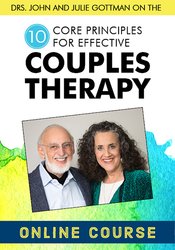How to Determine Which Couples You Can (and Cannot) Treat

When a struggling couple walks into your office, it’s natural to want to help. But one of the most important acts of clinical responsibility is knowing when not to take on, or continue with, a couple’s care. At this point, we invite you, as therapists, to look beyond technique and assess whether the couple’s needs truly fall within your scope of practice—and if not, how to refer them safely and ethically.
It begins with a clear and honest assessment of your own readiness. Ask yourself whether you’re trained and equipped to handle the specific issues a couple brings into the room. For example, trauma is incredibly common, and if you don’t have trauma-informed training, you may miss important dynamics beneath the surface. The same holds true for couples facing active substance use, personality disorders, suicidal ideation, or untreated mental illness. These are not just relational issues—they’re clinical risks that require specialized expertise. As therapists, we do a service to our clients and to ourselves when we know our limits and refer accordingly.
Perhaps the clearest red line is the presence of intimate partner violence. Before beginning any couples work, we advise conducting private interviews with each partner to assess safety. If one person expresses fear, describes controlling behavior, or hints that they can’t speak freely in front of their partner, therapy must pause. In these cases, joint therapy is not appropriate. This isn’t a communication breakdown—it’s a safety issue. The therapist’s role is no longer neutral; it’s protective. Continuing in a “both sides” approach when abuse is present not only fails to help, but it can also do active harm.
In more nuanced situations, such as affairs, addiction, or serious psychiatric symptoms, you must determine whether conjoint therapy is even viable at this stage. Has the affair been disclosed? Is the addiction active or in recovery? Is one partner overwhelmed by untreated mental illness that’s dominating the dynamic? If so, individual treatment may need to precede (or run alongside) any couples work. Sometimes the solution isn’t to reject therapy altogether, but to restructure it so that it meets the clients where they are, safely and realistically.
A therapist’s intuition is one of the most powerful tools in the room and one of the most telling clinical tools you have is your own emotional response. When you find yourself dreading sessions, feeling helpless, or confused about the truth in the room, those reactions matter. They’re data. They may be telling you that the therapy is no longer safe, productive, or aligned with your training.
But most importantly, referring a couple out is not a sign of failure. It’s a mark of ethical care. It says: I see what you’re going through, and I want to make sure you get the kind of support that will truly help. Therapists should invest in building a strong referral network like trauma-informed clinicians, substance use counselors, domestic violence advocates, culturally competent providers, so that when you recognize that something is out of scope, you have somewhere trusted to send your clients.
Ultimately, knowing who you can treat and who you cannot is not just about risk management. It’s about respect. It’s about honoring the complexity of couples’ lives, protecting their safety, and preserving your integrity as a clinician. Our goal isn’t to rescue every relationship. It’s to offer meaningful help to the couples we’re equipped to serve.
And sometimes, the most therapeutic act we can offer is a compassionate referral in the right direction.

In this exclusive online course, through masterful commentary, new in-session videos and detailed case studies, you'll discover how each of the Gottman 10 principles apply to successful couples work — and how you can implement these evidence-based principles in your practice to bring greater healing to your clients.





